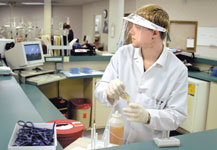Students ignore needle for $200 per month

Nick Bowers, of BioLife Plasma Services, processes plasma samples.
With the cost of a college education on the rise, many students are turning to alternative means of making money.
Some are choosing to donate plasma, the liquid part of blood, to make ends meet.
Paul Scoggin, manager of BioLife Plasma Services in Joplin said he gets 20-30 new donors per week.
According to BioLife Plasma Services, donor reimbursement per facility averages $1-1.5 million a year.
Scoggin said the donated plasma is used to manufacture pharmaceutical products for clotting factors, burn victims, surgical patients and individuals with immune disorders. He said the company makes between 30-50 different products, most of which cannot be made synthetically.
“It’s not like a unit of blood that is sold to a hospital,” Scoggin said.
Blood donations require the donor to wait eight weeks before donating again. With plasma donation, Scoggin said donors are able to donate twice in a seven-day period with 48 hours in between donations.
“If you eat a healthy diet your body will replenish the proteins within 48 hours,” said Andre Buechner, manager of marketing and corporate communication for BioLife.
“Plasma is 90 percent water with electrolytes and proteins,” he said.
Donors receive $20 for the first donation in a seven-day period, and $30 for the second.
“We have clients who donate 90-100 times a year,” Buechner said.
People donate for a variety of reasons.
Some donate because they knew someone who needed a product produced from plasma, said James Lofton, assistant manager of BioLife. Others donate for the compensation.
“Studies have been done comparing routine donors and new donors to determine if there are any long term health concerns,” Scoggin said. “There are no significant health concerns associated with routine donation.”
Scoggin said that donors give between 690-880 milliliters of plasma based on body weight. BioLife returns 500 milliliters in the form of saline. He said this leaves the donor with about a 20-ounce drink’s worth of fluid loss.
Sophomore psychology major Matt Harris said he has been a donor on and off for a couple of years. He said he donated out of the need for money.
Harris recently had “a near sinkable experience” while donating where he nearly lost consciousness.
“There are many vital nutrients in plasma,” Harris said. “I think people need to be aware of what they are giving up and the risks involved.”
“The donor is made well aware of the risks and benefits of donating plasma,” Scoggin said. “Every form has a tape that reads it for the donor, as well. The nurse stops the tape and explains the procedure and answers any questions.”
The initial physical lasts 30-45 minutes.
If the donor is not healthy or does not pass the physical examination, including proteins testing and disease testing, they are turned away.
“I don’t know of another company which plays tapes in order to ensure people’s safety,” Lofton said.
Extensive and continual training is needed for staff and phlebotomists.
“Our training is skill-based training,” Lofton said.
When a person shows proficiency in skill, they are able to work on the floor with patients.
Once on the floor, the training period is not over.
This period is followed by a series of direct and indirect observations.
“People learn at different rates,” Scoggin said.
“We are more strict than industry standards,” Lofton said. “From a regulatory standpoint, we go above and beyond to ensure safety.”
In November, BioLife Plasma Services will be moving into a new, state of the art facility will be opening across the street from the current location at 3201 McClelland Blvd.
Your donation will support the student journalists of Missouri Southern State University. Your contribution will allow us to purchase equipment and cover our annual website hosting costs.



























